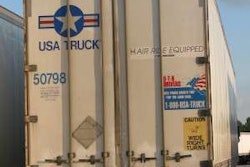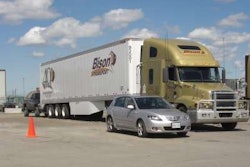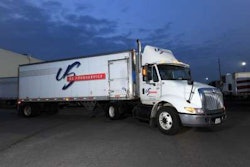Carlile Transportation Systems doesn’t just tell clients and prospects it can move their freight. The company says it can solve complex logistical problems.
Watch the History Channel’s “Ice Road Truckers” series, and you’ll understand why the company confidently can make such a claim. The History Channel contracted with the Anchorage, Alaska-based company to film several company drivers for the show’s third season.
The episodes show truckers moving heavy equipment on the 500-mile Haul Road from Fairbanks to the remote outpost of Deadhorse. Once the truckers reach the end of the highway in Deadhorse, they travel on a network of ice roads to the far-flung oil fields of Prudhoe Bay.
Not all of the company’s freight moves through the treacherous weather and unforgiving terrain of Alaska’s North Slope; the company also serves most of the state’s road-accessible markets. Operating in a small market in one of the harshest environments on Earth has given Carlile Transportation opportunities to establish itself as a full-service transportation company.
“In the (lower 48) states, carriers tend to be either truckload or LTL,” says Linda Leary, president. “They haven’t branched out as much. In Alaska, we have to do a little bit of everything.” A pivotal moment in Carlile’s 30-year history came in 1994 when the company purchased K&W Transportation from St. Cloud, Minn.-based Anderson Trucking Service. The acquisition enabled Carlile to provide interstate transportation between Alaska and the lower 48 states. “We doubled our business overnight,” Leary says.
Today, Alaska is the origin or destination for more than 85 percent of the company’s freight volume. Going forward, the company continues to leverage its unique experience in solving complex problems to create niche services in both Alaska and the mainland that are difficult for competitors to replicate. “We built it from the ground up, not from diving into it,” Leary says.
Carving a niche
As a full-service transportation company, Carlile provides truckload, less-than-truckload and intermodal services for rail, sea and air freight. The company is equipped to handle freeze and chill commodities, hazardous materials, bulk products, liquid products and specialized heavy-haul equipment, and it also operates a third-party logistics (3PL) service to manage individual projects for customers from single construction sites to entire supply chains.
Carlile operates about 300 truck and 1,500 trailers and pieces of trailing equipment. The reason for having such a high ratio of trailers to tractors is because Carlile’s trailers often are in transit between Alaska and the northwestern United States via steamship and barge lines. In the lower 48 states and Canada, Carlile operates terminals in Blaine, Minn.; Tacoma and Fife, Wash.; Houston; and Edmonton, Alberta.
Besides offering interstate shipping to Alaska from each of these locations, management has gone after niche markets in the mainland such as heavy-haul and oversized freight, bulk transportation, hazardous waste/materials and logistics support for the Department of Defense. Each of these markets began in Alaska.
At its Tacoma facility, Carlile operates a U.S. Customs-bonded container freight storage rail station. A CFS is a physical location for unpacking and packing intermodal containers.
The company also recently began operating a shipping service between the West Coast and Honolulu. Traditionally, national companies — i.e. shippers — have thrown Alaska and Hawaii into their international logistics divisions. Because Carlile is one of only a few domestic carriers that service both Alaska and Hawaii, the company does not compete directly with the so-called “national” interstate carriers in the minds of its customers, Leary says.
Solving challenges
A limited road network adds to the complexities of transporting freight in Alaska. Some areas only are serviceable by air or water. Companies that operate remote mines often will build a runway or ice roads. As a 3PL provider, Carlile manages all modes of transportation for customers in any kind of weather.
On the asset side, moving oil field supplies is one of many services the company offers, but its service goes beyond hauling freight. As the fields mature, they require increasingly larger equipment to keep production volumes up. Getting larger equipment out to remote sites is a significant challenge for shippers — and an opportunity for Carlile.
The company works with its clients’ engineering teams to determine the best weights and dimensions for oil field equipment to be transported safely to drilling locations in the Alaskan wilderness. Shippers also partner with Carlile to provide RFPs to potential buyers. With Carlile’s expertise, clients can quote accurate transportation costs along with the equipment. This guarantees that critical delivery commitments after the sale can be met, removing a major source of shipping headaches.
Carlile continues to find new opportunities to grow by getting customers to see the value of its services in entirely new ways. In the last couple years, the fleet has increased its presence in the commercial salmon industry by utilizing team driver operations to ship fresh and frozen goods to the mainland.
By truck, the trip from Alaska to Seattle takes between 52 and 60 hours. Few other companies have established runs between Alaska and the lower 48 by road. While the trip takes much longer than by plane, the costs are far less than airfreight, and transit time is much faster than by barge or steamship, Leary says.
Back to the basics
Because Carlile operates a diverse business, employees have to learn how to do many different tasks. Traditionally, new employees have learned by diving in, Leary says. Until recently, the company didn’t offer any formal training program. The need for one became apparent when Carlile implemented a new operations and dispatch software system earlier this year.
“I saw we needed training for employees, as well as a way to offer more value to our clients for helping them in training their employees,” Leary says. The company plans to launch Carlile University in January 2010 as a transportation training program.
For Carlile customers, the classes will be designed to meet the needs of people who are new to transportation such as a project manager with an engineering background.
“When working on a big project, it is always what you don’t know that can get you in trouble,” Leary says. For instance, when putting the project plans into place, the manager may not understand the road restrictions in Alaska during the spring and other regional idiosyncrasies that can affect their bids.
Initially, the classes will be offered for local customers once a month during lunchtime at the company’s headquarters. Leary also is considering conducting webinars and podcasts to reach a broader audience.
“For me, it is about building relationships with clients,” she says. “If we can be of help to our customers in training people, it is good for them and us.”













